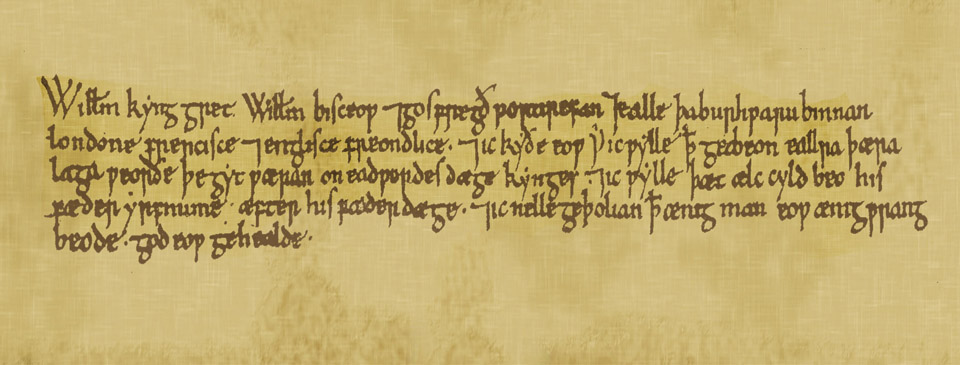In Brief – Saxons, Vikings and Normans

The text of the charter of reassurance issued to the people of London by William the Conqueror shortly after his coronation.
London was abandoned after England was separated from the Roman Empire in the 5th century and left as a ruin for 400 years. Control of the area then alternated between Saxons and Vikings. London was occupied once again during the reign of King Alfred of Wessex and by the time of the Norman conquest was a flourishing town.
London went into a long, slow decline during the period when the Roman empire was disintegrating in the late 4th century. After England separated from the empire in the 5th century the town came under attack and tribes of Angles, Saxons and Jutes from the Continent were invited to aid the country’s defence. The British fought among themselves, however, and the Germanic mercenaries took advantage, creating a network of kingdoms of their own.
London was gradually abandoned and most likely left as a ruin throughout the second half of the 5th and 6th centuries. The Saxons who inhabited the south-east of England during that time were farmers and fishermen. They had no use for the old town and instead created farming communities outside the walls.
Traders began to berth their boats on the sloping foreshore of the Thames to the west of London at what is now Charing Cross. A market and sizable community grew there, known as Lundenwic (London market). However, Viking invaders arrived during the second half of the 9th century and the undefended Lundenwic was abandoned. For some decades control of London and the surrounding areas alternated between the Vikings and the Saxon kingdoms of Mercia and Wessex.
Christianity was re-established in England in the 590s, with the arrival of the missionaries Augustine and Mellitus. In 675 Erkenwald was appointed as a bishop and he founded abbeys at Barking and Chertsey. When he died in 693 he was buried at St. Paul’s in London, thus indicating that a church had been established by that time. He was later canonised and became an early patron saint of London. Land was granted at Fulham to the Bishops of Essex in 704 and has remained the London home of subsequent Bishops of London into modern times.
Having fought the Vikings for many years, King Alfred of Wessex began to gain the upper hand. Following the death of the King of Mercia in 879 Alfred and his Viking counterpart divided Mercia between them. Thereafter the border between the two enlarged kingdoms ran along the River Lea. To its east the Vikings occupied Essex, and the territory to its west (including London) was under Alfred’s control. Yet the Vikings continued to pose a threat and Alfred set about creating ‘burghs’ – fortified communities – throughout his kingdom of the Anglo Saxons. London was re-established as a burgh within the old Roman walls.
In the following years Alfred granted areas of land within London to his trusted followers. Known as ‘sokes’, which grew into individual communities and were the origin of what is today the wards of the City of London. A royal palace was built. New streets were laid out, some of which remain today, and embankments were created along the river allowing ships to berth. Small wooden houses with thatched roofs were erected. Parishes were formed with churches that were probably initially built of wood but later of stone. Open-air public meetings called ‘folkmoots’ were held to make announcements and discuss matters of public interest. During that period only around a quarter of the space within the Roman wall was built over, with the remaining area probably used to graze animals and grow crops.


